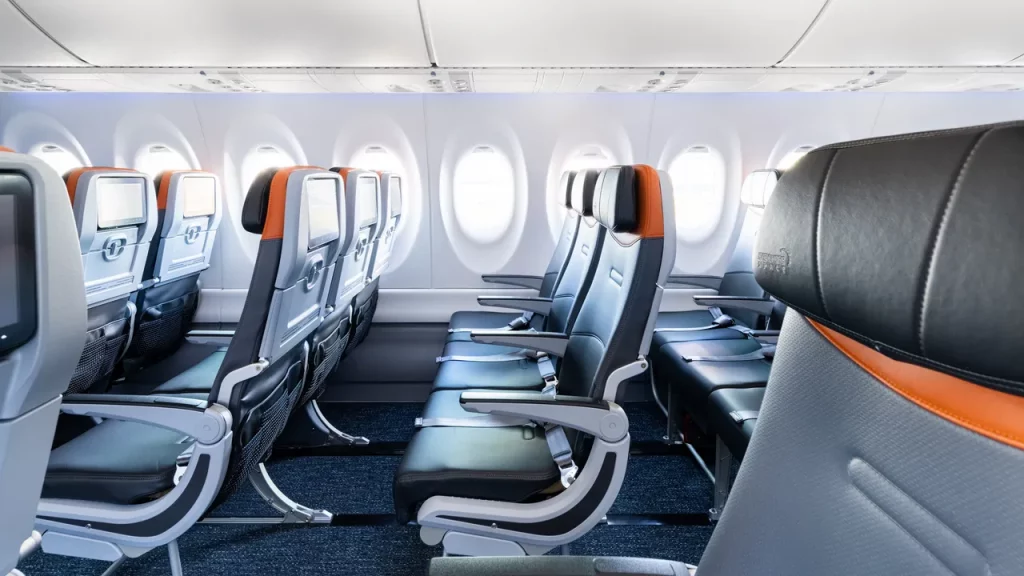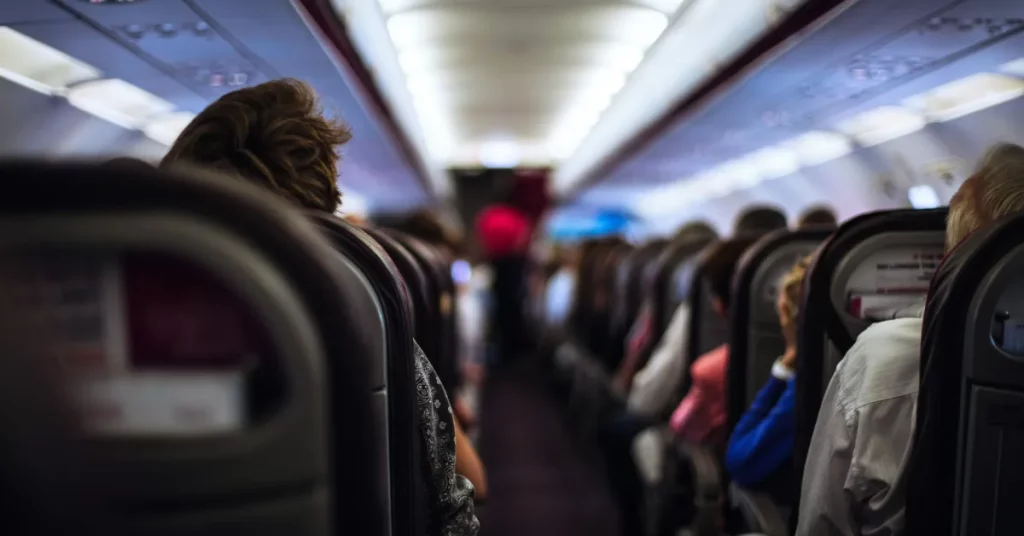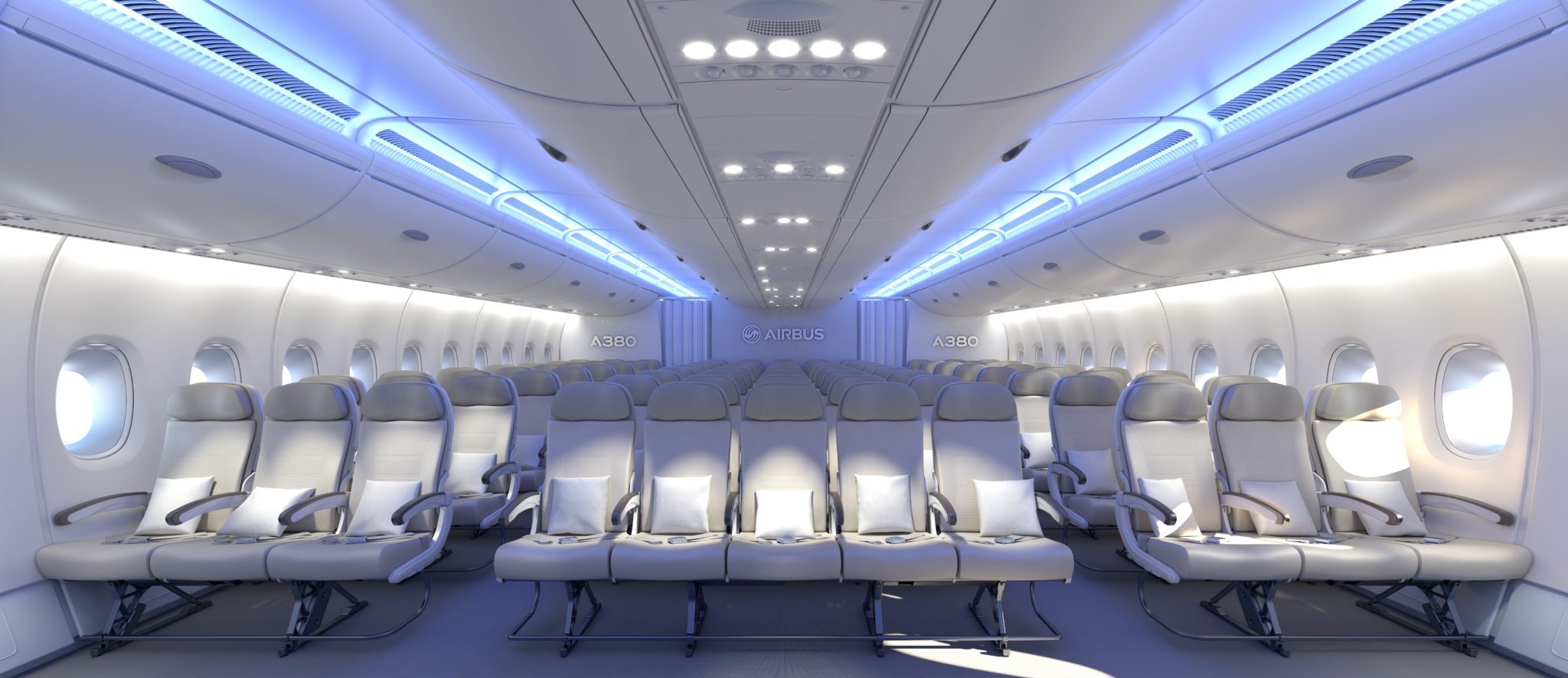The number of people fit in a plane can range from around 50 passengers for smaller regional jets to over 800 passengers for large commercial aircraft like the Airbus A380.
Different planes have different capacities based on their size and configuration.
Commercial airliners vary widely in size, with smaller regional jets seating around 50-100 passengers, while larger wide-body aircraft, such as the Boeing 747 or Airbus A380, can carry several hundred passengers.
Here are some general estimates for different types of commercial planes:
- Regional Jets: These smaller planes typically seat between 50 and 100 passengers.
- Narrow-Body or Single-Aisle Jets: These are medium-sized planes and are commonly used for short to medium-haul flights. They typically seat between 100 and 230 passengers.
- Wide-Body or Twin-Aisle Jets: These larger planes are used for long-haul flights and can accommodate anywhere from 200 to over 600 passengers. The exact capacity depends on the specific model and the seating configuration chosen by the airline.
- Very Large Aircraft (VLA): Some aircraft, such as the Airbus A380, are considered very large and can carry more than 600 passengers in a typical configuration.
Factors Affecting Seating Capacity

Factors influencing the number of passengers a plane can accommodate
- Aircraft Design:
Fuselage Design: The cross-sectional design of the fuselage significantly impacts seating capacity.
For instance, narrow-body planes (single-aisle) like the Boeing 737 or Airbus A320 typically seat between 100 and 230 passengers, while wide-body planes (twin-aisle) such as the Boeing 777 or Airbus A350 can accommodate 200 to over 600 passengers.
Wing Configuration: Efficient wing design contributes to fuel efficiency and range but also affects cabin space. For example, the Boeing 787 Dreamliner, known for its fuel efficiency, typically seats around 240 passengers.
- Aircraft Size:
Length and Wingspan: Larger aircraft generally have higher seating capacities. The Airbus A380, one of the largest commercial planes, can carry over 800 passengers.
In contrast, shorter-haul aircraft like the Embraer E175 regional jet seat around 80 passengers.
- Class Configurations:
Seating Layout: The choice of class configurations significantly impacts seating capacity.
For example, a standard two-class layout on a Boeing 737 might seat around 160 passengers, with adjustments based on the proportion of business and economy class seats.
Seat Pitch and Width: Variations in seat pitch (distance between seats) and seat width also affect capacity. Airlines may opt for more seats in economy class, sacrificing some comfort, or fewer seats with more space per passenger.
- Regulatory Requirements:
Safety Regulations: Regulatory standards dictate factors like the number and placement of emergency exits, affecting cabin layout.
Compliance with safety regulations ensures that the aircraft is designed to accommodate the maximum number of passengers safely. For instance, an Airbus A320, in a typical two-class configuration, may seat around 150 passengers.
- Aircraft Class and Type:
Regional vs. Long-Haul Aircraft: Regional jets are designed for shorter routes and, as such, have smaller capacities.
The Bombardier CRJ900, a regional jet, typically seats around 76 passengers. In contrast, long-haul aircraft like the Boeing 777-300ER can carry over 350 passengers.
- Market Demand and Airline Strategy:
Customer Demand: Airlines may tailor seating capacity based on market demand. For instance, premium-heavy configurations on certain routes may result in fewer overall seats.
Conversely, high-density configurations with more economy seats aim to maximize capacity for cost efficiency.
Airline Strategy: The business strategy of an airline influences seating decisions. Low-cost carriers often opt for higher-density configurations to maximize revenue per flight, while premium carriers may prioritize passenger comfort with fewer seats.
Regional Jets vs. Wide-Body Aircraft (The Comparison)
Regional Jets:
Example Models:
- Embraer E175: A popular regional jet manufactured by Embraer.
- Bombardier CRJ900: Part of the CRJ Series by Bombardier.
Typical Seating Capacity:
- Regional jets are designed for shorter routes and typically have seating capacities ranging from 70 to 100 passengers.
- For example, the Embraer E175 typically seats around 76 passengers in a standard two-class configuration, while the Bombardier CRJ900 can accommodate approximately 76 to 90 passengers.
Characteristics:
- Short to Medium-Haul: Regional jets are well-suited for short to medium-haul flights, connecting smaller airports and feeding passengers into larger hubs.
- Single Aisle: They usually have a single aisle, making boarding and deplaning efficient for smaller airports.
Common Use:
- Regional jets are commonly used by regional airlines and as feeder aircraft for larger carriers.
- They are crucial in connecting passengers from smaller cities to major airline hubs.
Wide-Body Aircraft:
Example Models:
- Boeing 777: A popular wide-body, long-range aircraft.
- Airbus A350: A modern wide-body aircraft known for its fuel efficiency.
Typical Seating Capacity:
- Wide-body planes are designed for long-haul flights and can carry a larger number of passengers.
- The Boeing 777, for instance, can accommodate around 300 to over 600 passengers, depending on the model and seating configuration. The Airbus A350 typically seats around 300 to 440 passengers.
Characteristics:
- Long-Range Capability: Wide-body aircraft are capable of flying long distances, making them suitable for intercontinental flights.
- Twin-Aisle: They have two aisles, providing more space for passengers and facilitating smoother boarding and deplaning.
Common Use:
- Wide-body planes are often used by major airlines for international routes, connecting major cities across the globe.
- They are equipped with amenities to make long-haul flights comfortable, including more spacious seating arrangements and additional in-flight services.
Summary: Regional jets and wide-body aircraft serve different roles in the aviation industry.
Regional jets are ideal for shorter routes and connecting smaller airports, while wide-body planes are designed for long-haul, international travel, catering to higher passenger capacities and providing additional comfort for extended flights.
The choice between these aircraft types depends on the airline’s route network, operational requirements, and the specific needs of the passengers they serve.
Iconic Aircraft Models and Capacities
Let’s explore some iconic aircraft models and their seating capacities:
Boeing 737:
Models: The Boeing 737 is one of the world’s most widely used and iconic aircraft. Various models include the 737-700, 737-800, and 737 MAX series.
Seating Capacity: The seating capacity of the Boeing 737 varies depending on the model and configuration.
In a standard two-class configuration, the 737-800 typically seats around 162 passengers, while the newer 737 MAX 8 can accommodate approximately 178 passengers.
Boeing 777:
Models: The Boeing 777 is a long-range, wide-body twin-engine jet. It comes in different models, such as the 777-200 777-300, and extended-range variants like the 777-200ER and 777-300ER.
Seating Capacity: The seating capacity of the Boeing 777 varies based on the model and configuration.
The 777-200 typically seats around 317 passengers in a three-class configuration, while the larger 777-300ER can carry approximately 396 passengers in a similar layout.
Airbus A380:
Model: The Airbus A380 is the largest passenger aircraft in the world, known for its distinctive double-deck design.
Seating Capacity: The seating capacity of the Airbus A380 is substantial. In a typical three-class configuration, it can seat around 555 passengers.
However, configurations can vary, and some airlines have opted for higher-density layouts, accommodating well over 600 passengers.
Airbus A320:
Models: The Airbus A320 family includes the A318, A319, A320, and A321, with various seating capacities to cater to different market segments.
Seating Capacity: The A320 series is widely used for short to medium-haul flights.
The A320, for example, typically seats around 150 passengers in a two-class configuration. The longer A321 can accommodate up to approximately 240 passengers.
Boeing 747:
Model: The Boeing 747, often referred to as the “Queen of the Skies,” is a legendary wide-body aircraft.
Seating Capacity: The Boeing 747 has undergone various iterations, and the seating capacity varies accordingly. For instance, the Boeing 747-400 can seat around 416 passengers in a three-class configuration.
However, some airlines configured it to accommodate more than 500 passengers.
These iconic aircraft have played significant roles in shaping the aviation industry, offering a range of capacities to suit diverse airline needs.
The choice of aircraft depends on factors such as route length, passenger demand, and an airline’s overall operational strategy.
Airline Configurations
Airlines configure their planes based on a variety of factors, including the type of routes they operate, the preferences of their target market, and their overall business strategy.
Including first class, business class, and economy class significantly impacts the overall seating capacity and the level of comfort and services offered to passengers. Here’s how these classes influence aircraft configurations:
First Class:
- Configuration Impact: First class is associated with the highest level of luxury and service. Airlines offering first-class cabins have fewer seats in this class to provide more space, privacy, and premium services.
- Seating Capacity: While the specific number of first-class seats varies, it is generally a small percentage of the total aircraft capacity. For example, a long-haul aircraft might have around 6 to 12 first-class seats, depending on the airline and aircraft model.
Business Class:
- Configuration Impact: Business class offers a balance between comfort and cost. Airlines configure business class with larger, more comfortable seats than economy class, often featuring lie-flat beds for long-haul flights.
- Seating Capacity: The number of business class seats varies widely. In a typical configuration, business class may constitute around 15% to 30% of the total seating capacity. For example, a Boeing 777-300ER might have around 40 to 60 business-class seats.
Economy Class:
- Configuration Impact: Economy class is designed for cost efficiency and higher passenger capacity. Seats are more densely arranged, and legroom may be more limited compared to premium cabins.
- Seating Capacity: The majority of the seats on an aircraft are in the economy class.
On a typical commercial airliner, economy class can account for around 70% to 85% of the total seating capacity. For instance, a Boeing 737-800 might have approximately 150 to 180 economy-class seats.
Premium Economy:
- Configuration Impact: Some airlines also offer a premium economy class, providing more comfort than standard economy but at a lower cost than business class. This class typically features larger seats, extra legroom, and enhanced services.
- Seating Capacity: Premium economy class usually constitutes a smaller percentage of the total seating capacity, roughly around 5% to 15%, depending on the airline and the aircraft type.
Configurations Based on Routes:
Airlines may adjust their configurations based on the type of routes they operate.
For long-haul international flights, premium cabins may have a higher percentage of the total seating capacity, catering to passengers willing to pay for enhanced services.
On short-haul or regional routes, airlines may opt for higher-density configurations to maximize the number of passengers and increase cost efficiency.
Flexible Configurations:
Airlines often have the flexibility to adjust seating configurations based on market demand, seasonal trends, and changing economic conditions.
Some aircraft are configured with modular cabins that allow for easy reconfiguration to adapt to changing circumstances.
In conclusion, the inclusion of different classes in an aircraft’s configuration allows airlines to cater to a diverse range of passengers with varying preferences and budgets.
It also allows them to optimize revenue streams by offering premium services to those willing to pay a premium fare while also providing more cost-effective options for budget-conscious travelers.
Innovations in Aircraft Design
Recent innovations in aircraft design have been focused on enhancing fuel efficiency, reducing environmental impact, improving passenger comfort, and optimizing seating capacities.
Here are some notable innovations that may impact seating capacities:
Composite Materials:
- Innovation: The increased use of composite materials, such as carbon-fiber-reinforced composites, in aircraft construction has led to lighter and more structurally efficient airframes.
- Impact on Seating: Lighter materials contribute to reduced aircraft weight, which, in turn, can positively impact fuel efficiency.
- Airlines may choose to maintain current seating capacities with a lighter aircraft or increase seating while maintaining the same weight.
Advanced Wing Designs:
- Innovation: Innovations in wing designs, such as winglets and more aerodynamically efficient shapes, contribute to improved fuel efficiency by reducing drag.
- Impact on Seating: More efficient wings can enable aircraft to achieve better fuel efficiency, potentially allowing airlines to operate with the same or increased seating capacities while maintaining cost-effectiveness.
Blended Winglets:
- Innovation: Blended winglets curve upward at the wingtips, reduce drag, and improve fuel efficiency.
- Impact on Seating: While not directly influencing seating capacity, blended winglets can enhance the overall efficiency of an aircraft, contributing to fuel savings and potentially influencing an airline’s decision on seating configurations.
Innovative Cabin Configurations:
- Innovation: Airlines are exploring new cabin layouts and configurations to optimize passenger space and comfort. This includes rearranging seats, introducing new seating designs, and utilizing smart cabin layouts.
- Impact on Seating: Innovative cabin designs can influence how space is utilized, potentially allowing airlines to maintain or increase seating capacities without compromising passenger comfort.
Modular Cabin Concepts:
- Innovation: Some aircraft manufacturers are exploring modular cabin concepts, where the interior can be quickly reconfigured to meet changing demands or specific routes.
- Impact on Seating: This flexibility could allow airlines to adapt seating configurations based on factors like seasonal demand, route characteristics, or special events.
Lighter Seats and Materials:
- Innovation: Manufacturers are developing lighter yet durable materials for seats. Lightweight seats contribute to overall weight reduction.
- Impact on Seating: While the primary focus is on passenger comfort, lighter seats can contribute to an aircraft’s overall weight reduction, potentially allowing for increased seating capacities without sacrificing fuel efficiency.
Aircraft Connectivity and In-Flight Entertainment:
- Innovation: Improved in-flight connectivity and entertainment systems enable airlines to offer a range of services to passengers, enhancing the overall travel experience.
- Impact on Seating: Enhanced entertainment options may influence passenger perceptions of comfort, potentially allowing airlines to explore different seating configurations that balance passenger experience with capacity.
These innovations collectively contribute to the ongoing evolution of the aviation industry, aiming to enhance both operational efficiency and passenger experience.
As airlines strive to balance these factors, future aircraft designs may see continued improvements in seating capacities without compromising safety, comfort, or environmental sustainability.
Cargo Planes and Passenger Conversions

Cargo planes can be converted for passenger transport in certain situations, especially when there is a need for temporary or specialized passenger transportation.
The conversion process involves modifying the interior of the aircraft to accommodate passengers, including installing seats, lavatories, and other necessary facilities.
Here’s a brief overview of how cargo planes can be converted and its impact on seating capacities:
Conversion Process:
Temporary Conversions: In times of high demand for passenger transport or during emergencies, cargo planes may undergo temporary conversions to transport passengers.
This process is often reversible, allowing the aircraft to return to its original cargo configuration after the need for passenger transport diminishes.
Interior Modifications: The cargo hold is modified to include seating arrangements, lavatories, and other amenities required for passenger comfort and safety.
Regulatory Approval: Turning a cargo plane into one for passengers means getting aviation authorities’ permission to ensure it’s safe and secure.
Impacts on Seating Capacities:
Reduced Seating Capacity: Cargo planes converted for passenger transport generally have lower seating capacities than purpose-built aircraft.
The interior layout may not be as optimized for passenger comfort, and the primary focus is often on providing a safe and functional environment.
Varied Configurations: The seating configuration in converted cargo planes can vary based on the aircraft model, the specific conversion design, and the operator’s requirements.
Depending on the intended use, seating arrangements may range from a more spacious layout to a higher-density configuration.
Examples of Passenger Conversions:
- Boeing 747:
The Boeing 747, a well-known cargo aircraft, has been converted for passenger transport in certain situations. The upper deck of the 747 is sometimes utilized for passenger seating.
- Airbus A330 and A340:
These wide-body aircraft have been used in cargo operations and can be converted for passenger transport. The flexible design allows for variations in seating configurations.
Flexibility and Adaptability:
- Emergency Response: Cargo-to-passenger conversions are often employed in emergency response situations, such as evacuations or repatriation flights, where the need for transporting passengers arises suddenly and may not justify deploying dedicated passenger planes.
- Specialized Travel Needs: Some operators may convert cargo planes for specific types of passenger transport, such as charter flights for large groups or sports teams.
While cargo-to-passenger conversions offer a flexible solution for temporary passenger transport needs, it’s important to note that these configurations may not provide the same level of comfort or amenities as purpose-built passenger aircraft.
Additionally, safety and regulatory considerations play a crucial role in determining the feasibility and approval of such conversions.
FAQs
What is the typical seating capacity of a commercial airplane?
Most commercial airplanes have a seating capacity that ranges from around 100 to over 600 passengers, depending on the aircraft type and configuration.
How are seating capacities determined for different airplanes?
Seating capacities are determined based on factors such as the aircraft’s size, layout, and the airline’s preference. Regulations and safety standards also play a role in establishing the maximum number of passengers.
Do all passengers on a plane have the same amount of space?
No, seating arrangements vary, and some passengers may have more legroom or amenities depending on the class of service (economy, business, or first class) and the airline’s configuration.
Can a plane exceed its maximum seating capacity?
No, airlines must adhere to safety regulations and an aircraft’s certified maximum seating capacity. Exceeding this limit would compromise safety standards.
How are seat configurations determined on a plane?
Seat configurations are determined by airlines based on their business models and passenger preferences. They consider factors like comfort, class divisions, and the overall flight experience.
Are there restrictions on the number of passengers for smaller private planes?
Yes, smaller private planes have limitations on the number of passengers they can carry, usually based on the aircraft’s design and certification.
What is the impact of cargo on the seating capacity of a plane?
The inclusion of cargo can impact the available space for passengers. Some planes are designed to accommodate both passengers and cargo, but the configuration may vary.
Do different aircraft models have similar seating capacities?
No, seating capacities vary significantly among different aircraft models. Larger planes, like jumbo jets, generally have higher capacities than smaller regional or private planes.
Are there regulations regarding passenger comfort and space on airplanes?
Yes, there are regulations regarding passenger comfort and space on airplanes.
Aviation authorities set regulations to ensure a minimum level of passenger comfort and safety. However, specific details may vary; some airlines provide more space and amenities than required.
Can airlines change seating configurations on planes?
Yes, airlines have the flexibility to change seating configurations on planes, subject to regulatory approvals and safety considerations.
What is the importance of load balancing in determining seating arrangements?
Load balancing is crucial for maintaining the stability and safety of an aircraft. Seating arrangements are designed to distribute the weight evenly, ensuring the plane remains balanced during flight.
Conclusion
To put it simply, how many people can fit on a plane depends on its size, design, and how the seats are arranged.
For example, a massive plane like the Airbus A380 can carry over 800 passengers, while smaller ones may only fit around 50.
Airlines also decide how much space each passenger gets, considering things like seat width and legroom. It’s like figuring out a puzzle to ensure everyone fits comfortably and safely.











